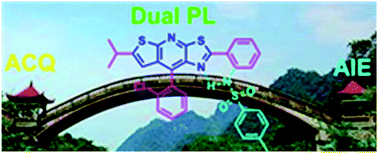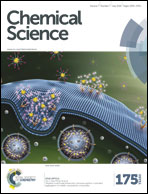An arch-bridge-type fluorophore for bridging the gap between aggregation-caused quenching (ACQ) and aggregation-induced emission (AIE)†
Abstract
Solution and solid dual photoluminescence (PL) molecules fill the substantial gap between ACQ and AIE molecules to explore the mechanism of molecular luminescence in greater detail and to facilitate practical applications. A unique arch-bridge-like thiazolo[5,4-b]thieno[3,2-e]pyridine moiety is obtained as a stator after the rigidification of rotor 1 by intramolecular H-bonding of ortho –OH or –NH2 to afford two classes of solid and solution dual PL molecules. As a typical example, DF5 is dual PL active. Moreover, the large Stokes shift with high dual PL efficiency (ΦF up to 51% in the solid state, 80% in DMF, 74% in DMSO, and 100% in water), together with the good thermal stability (Tm > 200 °C and T05 > 200 °C), make it more practical for promising optoelectronic and biological applications.


 Please wait while we load your content...
Please wait while we load your content...